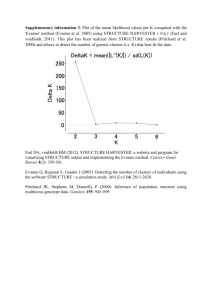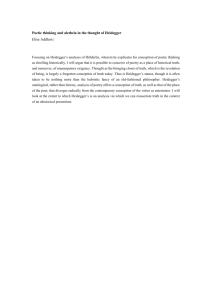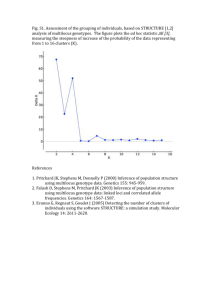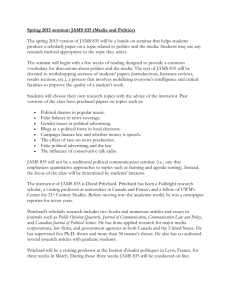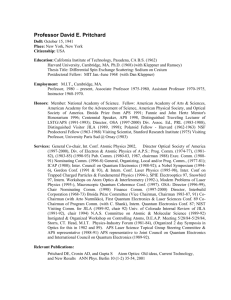On Pritchard
advertisement
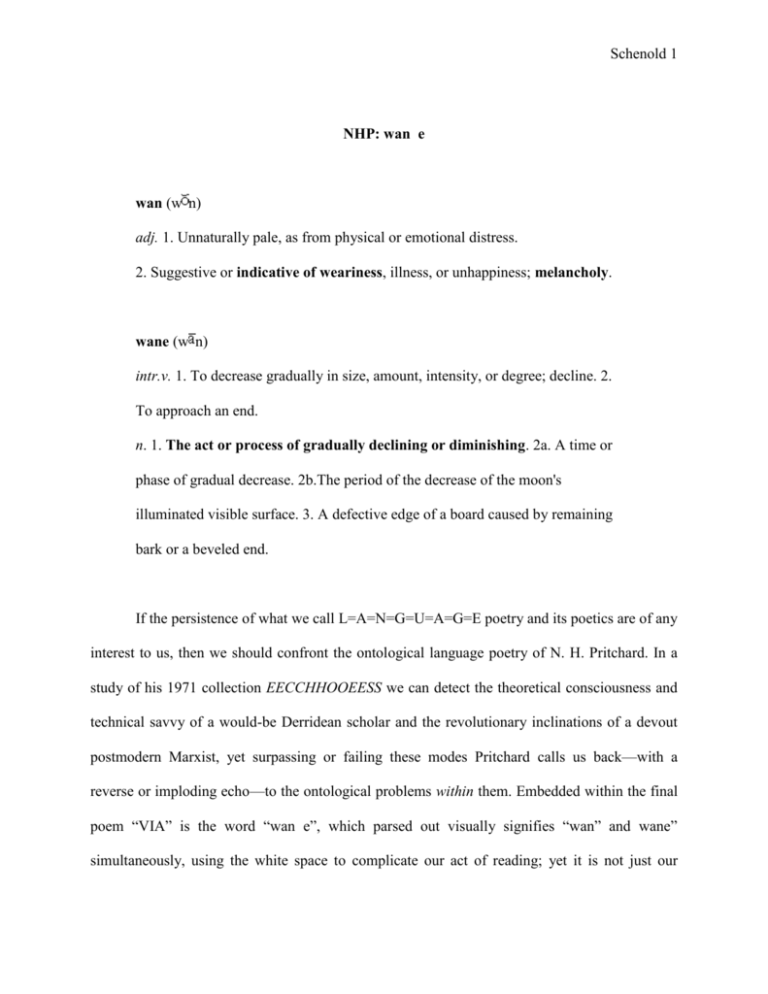
Schenold 1 NHP: wan e wan (w n) adj. 1. Unnaturally pale, as from physical or emotional distress. 2. Suggestive or indicative of weariness, illness, or unhappiness; melancholy. wane (w n) intr.v. 1. To decrease gradually in size, amount, intensity, or degree; decline. 2. To approach an end. n. 1. The act or process of gradually declining or diminishing. 2a. A time or phase of gradual decrease. 2b.The period of the decrease of the moon's illuminated visible surface. 3. A defective edge of a board caused by remaining bark or a beveled end. If the persistence of what we call L=A=N=G=U=A=G=E poetry and its poetics are of any interest to us, then we should confront the ontological language poetry of N. H. Pritchard. In a study of his 1971 collection EECCHHOOEESS we can detect the theoretical consciousness and technical savvy of a would-be Derridean scholar and the revolutionary inclinations of a devout postmodern Marxist, yet surpassing or failing these modes Pritchard calls us back—with a reverse or imploding echo—to the ontological problems within them. Embedded within the final poem “VIA” is the word “wan e”, which parsed out visually signifies “wan” and wane” simultaneously, using the white space to complicate our act of reading; yet it is not just our Schenold 2 reading that is challenged. If we come to the poetry with an historical sense of the poetries of the 60’s and early 70’s, particularly the Beat and the Black Arts movements, and we also consider the title of the collection, then our expectations for the aural performance of these lines are also disrupted. This small example is just one of the many ways in which time and space, poetic lexicon and line, “breath”, syntax, subject, etc. all seem to be challenged in the most fundamental moments of their trace usage throughout the collection, and we are almost left with what Pritchard might call pure “content” (more on this later). Pritchard was already thinking about this in his earlier collection The Matrix, where he asserts in the epigraph: “Words are ancillary to content.” Unfortunately, Pritchard’s poetry has been rendered ancillary by the overly rigid historical and political frames used to anthologize poetry, and his arguable foreshadowing of the poetics to come has remained almost completely unrecognized. Aldon Lynn Nielsen’s Black Chant: Languages of African-American Postmodernism is the only book-length work of criticism to date that mentions Pritchard’s poetry, and he limits his treatment to a necessarily short and invaluable survey of Pritchard’s historical reception among contemporaries, mainly regarding The Matrix poems. Nielsen also has several insights into some of the poems in EECCHHOOEES, most notably “junt,” which he laments as an aesthetically “transgressive” poem that has been lost in the shuffle by the “critics of white poetry” who largely ignore black writers while “compiling their genealogies of aesthetic evolution” (13). In the short survey of the critical reception of The Matrix, Nielsen finds the commentary of W. Francis Lucas in Liberator magazine particularly illuminating, and in light of the scarcity of such reflection I find it important enough to quote at length: The terminology of Lucas’s notes is striking in retrospect. He said of Pritchard’s work, ‘These poems decompose the reader by sight and sound’ (12). This was Schenold 3 1967, before English translations of Derrida, Lacan, and Kristeva had become standard fare for graduate literary study, before deconstruction and other forms of poststructuralist critique had had much opportunity to alter the critical vocabulary of book reviewers. More importantly , we see in this instance that Lucas was free of the all too common assumption that experimental approaches to expression and theorized reading are somehow white things. However we account for the absence of Pritchard from contemporary discussions about postmodern poetics and language, it seems clear that the “all too common assumption” that Nielsen underscores above plays a significant role in silencing the voice of Pritchard. This racially charged assumption is complicated and shifted to the problem of historical context in the only other published work of criticism that addresses Pritchard. Kevin Young’s article "Signs of Repression: N. H. Pritchard's The Matrix" appearing in the Harvard Library Bulletin in 1992 also puzzles over the absence of Pritchard from critical discussions, suggesting that his poetry is difficult to position or place in historically established literary movements. Arguing for Pritchard in a themed occasion of the journal that sought to address, “The Renaissance of Material Poetry,” Young laments that “Pritchard seems positioned outside whichever definition of ‘concrete’ is chosen, whether Black reality or reader-oriented physicality” (27). What both of these accounts indirectly point to is a problem with historicizing, or at least over-historicizing writers that are presumably “on the margin.” Nielsen’s vast scope and largely historical approach honorably casts Pritchard as a neglected Umbra poet, locating the tragedy almost wholly in neglect by critics. While it is obviously important to parse out the fate of Pritchard within tradition, as Nielsen begins, it seems somewhat counter productive to persist in this mode if our aim is to redeem the more latent, possibly original contributions of the poetry. Schenold 4 The political question of why we have not heard the echo of Pritchard’s poetry today collapses quickly into an ontological question that the poetry itself seems to ask: What (is it that) echoes? Although historicizing EECCHHOOEESS may be useful in extrapolating some generative implications of the poems, the text itself calls for something quite different. The contention here is not that discussions of say, how Pritchard’s poetry relates to “black orality and identity” in the Umbra collective, the concurrent, aurally centered movements of the Black Arts, or Pritchard’s own participation in the sound recordings of the New Jazz Poets, but rather that those approaches seem “ancillary” to the problems that the poems of EECCHHOOEESS seem to posit. Therefore, the following exploration of Pritchard takes its cue from the intimation of ontology found within the paradoxes of the poems, and what is sought is a preliminary analysis of how Pritchard, through ontologically inspired modes, not only presupposes the aspirations of L=A=N=G=U=A=G=E poetry, but also points out an obstacle that is hitherto unrecognized (or at least marginalized) by postmodern Marxist language poets like Andrews, Bernstein, Silliman, and Watten. What echoes for us in the context of contemporary poetry is Pritchard’s lament of the (wan e)-ing of concern for poetry—for the ontology of language. Not just “black” language and poetry, but Poetry and Language. To assume that Pritchard’s apparent struggles in EECCHHOOEESS only speak to African-American politics and issues is too limiting, and the poetry itself suggests a more philosophical treatment is in order. Pritchard and Heidegger’s Ontology Although it would be impossible to do Heidegger’s philosophical developments justice in this space, even if we confine ourselves to dealing only with the later works on language, it is my view that even a very limited employment of the basic critical movements produce rich results in Schenold 5 reading the poems of EECCHHOOEESS. Many poets were aware of Heidegger and his often cited claim that “language is the house of Being,” as Nielsen notes, and it is a reasonable assumption that Pritchard had been exposed to this in some way. However, as I shall indirectly argue, the earlier Heidegger of Being and Time is just as relevant here, and in fact gets the final word through Pritchard. Some scholars might also take up Derrida in place of Heidegger altogether as the more contemporaneous figure, having presumably supplanted the later Heidegger with his own theories. However, the poems “FR / OG”, “carbon”, “WE NEED PEOPLE”, and “SHROUD” clearly suggest grappling with ontological anxieties, while poems like “.d.u.s.t.”, “THE WATCH”, “VIA” and the very structuring of the collection (the separating pages of 1’s, 2’s and 3’s) suggest a consciousness of temporality—if only specifically through intimations of decay with the use words like “waning”, “diminishing”, “DESCENDING”, and “wan e”. Instead of laboring over the nuances of the various moments of Heidegger’s philosophy I would like to have Pritchard’s poetry lead, using the early Heidegger to help comment on the ontological issues that arise, and the later Heidegger to lend Pritchard’s poetry more theoretical vocabulary when dealing specifically with the formations of language. In the end analysis it may be concluded that Heidegger’s ideas about ontology and language only confuse Pritchard’s poetry, or that they are only thematically related in a very superficial way, but in spite of this liability the comparisons will be an intriguing entry point into an unexamined poetry. F R / O G and the Ontological Chain of Simile Pritchard’s first poem “FR / OG,” which is preceded by two solid pages of 1’s, immediately undermines traditional expectations of the poetic line, and draws our attention to spaces. We are presented with a typographical or visual echo of the conjunction “as”, but no Schenold 6 apparent subject. This echo descends the first page and moves quickly from the designating plural “as” to the more complicated yet focused singular “as a” on the second page which continues until it disappears on the last page. Theoretically, Pritchard signifies no beginning or end to the poem via the text (words), since they appear and reappear at the topmost position of the pages and disappear at the bottommost position. The absence of any punctuation, most notably periods, also makes an oral reading of this poem problematic. The missing subject to the mostly sporadic, verb-less predicates that follow the interminable column of conjunctions may be filled by the imagined “frog” that is suggested in the askew title matrix of F-R, O-G, but it works better as a hint to how the invisible and aimless subject intervenes in the stream of conjunctions. The undesignated subject leaps from contextual points in the continuum of language, or even of signification, and “projects” various likenesses or circumstances. Although we do not get what (subject) or in what way/how (verb) these projections come into being in the poem, we do get the remainders or traces. The dominating lines “as a hoo” and “as a hoo hooz” would suggest that the missing subject(s) and verb(s) are the question or the challenge of the poem. Heidegger’s concept of the Dasein as articulated in Being and Time helps illuminate some of the questions that arise out of Pritchard’s absent subject(s). Dasein can be viewed as Heidegger’s philosophically posited subject that stands in for humanity, the entity—“man himself”—whose very “Being is an issue for it” (32). Anytime that we specify a subject or account in any way for beings by designation, we are thinking “ontically,” as opposed to “ontologically,” in which we reflect only on the universal nature of Being. Heidegger expresses the relationship between Dasein and these modes of inquiry by stating that “Dasein is ontically distinctive in that it is ontological” (32). While the terms are very difficult to work with, the core Schenold 7 of the problem Heidegger is trying to clarify is the failure of any finite, specified, “ontical” subject to provide any meaning or understanding of Dasein. What is important here in relation to Pritchard’s poem is the function of Heidegger’s insight on the subject. Without the subject and verb there is no discernable will, and no “ontical” subject from which we can extract any meaning or found any interpretation beyond our own. Whatever does what “as vying orbs make their pledge” or “as a plane matched utmost by its wedge” we cannot depend on Pritchard or the text or the poem for help. We may imagine a subject locally on each line, working backward from the dangling, inert predicate by asking questions like: What object or person would do what “as a sneeze protruding on a field”? There are suggestions for deciding, but Pritchard’s poem will not relinquish a definitive subject between any two broken predicates, and certainly not one attained by any conceptual accrual of them. This particular problem in “FR / OG” is similar to Heidegger’s idea of the “throwness” of Dasein, on which he asserts that “Dasein is thrown into the kind of Being which we call ‘projecting’” (185). Clarifying his terms, he continues: “Projecting has nothing to do with comporting oneself towards a plan that has been thought out, and in accordance with which Dasein arranges its Being. [ontically] On the contrary, . . . Dasein always has understood itself and always will understand itself in terms of possibilities” (185). Pritchard calls us into a hermeneutic circle through language, by the structural designation that resists the ontical and opens up to the ontological. In a way, “language speaks,” as Heidegger remarks in his essay “Language,” and Pritchard’s repetition of the conjunction “as” does little violence to the possibilities of our imagination. Insofar as we struggle against the throwness of interpretive freedom, indulging the inclination to calculate the subject and the will (an ontical struggle that yields no meaning), the incessant repetition of conjunction and indeterminate predicates “hoo Schenold 8 hooz” lead us to hermeneutic anxiety. This anxiety, Heidegger argues, “runs through the chain of beings,” and is understood only through ontology. Pritchard’s use of the “as” in the poem suggests a postmodern valuation of interpretation, a view Richard E. Palmer explores in the works of Heidegger. Being and Time addresses the ontological function of the word “as”, when Heidegger states that “the ‘as’ makes up the structure of the expressability of what is understood—it constitutes the interpretation” (Palmer, 76). In “The Postmodernity of Heidegger” Palmer argues that Heidegger’s contribution through ontology is the insight he offers into the analytic of interpretation, asserting that The roots of Heidegger’s thought remain in the nameless, the unsaid, the unthought. One could almost say that thrust of Heidegger’s thought is to preserve the significance of this area of indeterminacy for interpretation: interpretation is not simply a manipulation of what is already manifest, it is pre-eminently the bringing of a certain light to bear on what is. (87) [my italics] Palmer calls this “postmodern interpretive awareness” (88), a quality which we can also attribute to Pritchard in “FR / OG”. The column of conjunctions throws us into language, which I remarked is a confrontation with the hermeneutic circle that produces anxiety. This “hermeneutic circle” is meant to describe the reality that “all human inquiry is circular. . . [and any] effort to avoid the hermeneutic circle, to achieve objectivity, a presuppositionless stance, therefore, is not only a futile gesture; it also does a violence to the truth by way of concealing that which it is supposed to reveal” (Spanos, 117). Writing on similarities between Kierkegaard and Heidegger, arguing that both arrive at the reality of the “Hermeneutic Circle,” Spanos offers the following insight: Schenold 9 Just as Kierkegaard’s narrative strategy of repetition is a ‘dialectics of revocation,’ which in denying the reader an author-ial ground breaks the ‘metaphysical’ circle of interpretation and ‘assigns him to himself,’ so a Heideggerian hermeneutical circle is a process of de-struction, or dis-closing, which dismantles the reader’s metaphysical/spatial frame of reference and assigns being-in-the-world, in original and care-ful, i.e. dialogic, relationship to the being of the text and ultimately to being itself. (135-6) The reader must engage in an ontological analytic because Pritchard’s poem assigns her to herself—the will that asks the what, which is perhaps the “ruined” will in “VIA”. It is the repetitive presentation of the conjunction “as”—the “structure of the expressability of what is understood,” according to Heidegger—that positions the reader within language. That Pritchard never places a subject or verb before the conjunction throughout the poem is significant: when the subject and intention (action) are asserted as space (or not asserted) there is an echoing of the interpretive will which keeps the poem open with the force of its own condition. Pritchard draws attention to the openness of language as “content” that “words” often attempt to close. Form and content do not seem opposed for Pritchard, but rather aligned against the word (or words), which are “ancillary”. What is important is what is there or not there: the content. The use of words, specifically as names or signatures of a subject, is ancillary and in some cases counterproductive. In his book on Heidegger’s poetics, Marc Froment-Meurice remarks that the ontical always destroys the ontological: Being loses itself in its signature, in this double that it nonetheless has incited, that should have been but a lieu-tenant, a placeholder, a substitute, but that has played Schenold 10 its role so well, has held the place of Being so well, that it has become Being, literally exempting Being from being present—as Being. (45) Pritchard, like Froment-Meurice’s Heidegger seems to have a similar attitude. Pritchard has a poetic interest in staving off specificity insofar as it may lead to a seductive (yet always terrorizing) “fact” of being (or of the poem). The word destroys the potentialities of the poetic echo if it plays its role too well, which is to designate absolutely and to at least attempt to close the “hermeneutic circle.” While Pritchard’s chain of broken similes surely invoke more questions than poetic assertions, an ontological approach to those questions seems to be foregrounded here. The “what” of the poem is clearly what drives it, and whether we move associatively through the inert predicates or try to reconstruct in reverse seems to be an ontological issue. Yet, the opening series of “as” can be read as statements of simultaneity, as something that is or happens at a designated time: “as vying orbs make their pledge” or “windy puddles predict the sun.” This possible interpretation introduces temporality into the content, or perhaps re-introduces it after its implication in the title of the collection. Readings attentive to time are reinforced by many of the poems in the “2’s” section which bring concepts and images of temporality to bear on the ontological struggles posited by “FR / OG.” The “cries that have no why” and the “forums of ruined will” Contrary to the unrelenting persistence of the tower of “as”, the incessant stream of the content of language, the middle poems begin to suggest a deterioration, a sedimentation that may indicate the “forums of ruined will” that we will find later in “VIA.” The first poem, “.d .u .s .t .” suggests the troubled passage of time but will not adhere to a narrative or teleology of that Schenold 11 suggestion. We read the words “dust”, “waning”, “wilt” as suggestive of decay, culminating in the image of the “tattered and stitched bones” that are mysteriously “sprinkled because” at the close of the poem. Visually, the words themselves appear among the dust of the periods “…”, and we may relate them to the tattered bones within the poetic image that, we are told, are “sprinkled because. . . .” But the unresolved “because” leads us to ask why. Are the words of the poem, which may be like the fossil bones that return to dust, ultimately the “cries that have no why” in the poem “SHROUD”, or are we inspired to give reason? Perhaps the “maw of waning” that is the voracious mouth of the poet that speaks with a “wilt beak.” Whatever the will is behind the poems significations, it willed them in the past: the words “wrung”, “poured”, and “sprinkled” suggest like “.d .u .s .t .” that the phenomenon has passed, trailing in “. . . .”, leaving us to wonder why. This sense of finality and reflecting back is continued in “M I N T” where Pritchard begins with “are or didn’t.” Whatever follows, these words in the poem are already the way they are, or whatever was “didn’t” act. We are thrown into a happened existence, into a “mint”, which can be construed as a place or source of manufacture or invention. To go on in the poem we must fabricate connections between the “milk” and the “huge ba / llons in them toes.” If, as Heidegger suggests, that “everyday language is a forgotten and therefore used-up poem, from which there hardly resounds a call any longer” (Language 208), Pritchard uncovers the process by which the “call” of words and language ceases to echo. Presented like a matrix of letters, the poem forces the reader to become conscious of the routines of reading, of the parsing of words and sentences—the unconscious linguistic (and ultimately ontological) generation or minting of coherence. Just as Heidegger warns that “we do not wish to reduce the nature of language to a concept,” Pritchard seems to challenge the reader here to adopt a similar concern. By replacing Schenold 12 the word “language” with “poetry” in the following quotation from Heidegger (an equation he explicitly makes elsewhere), we arrive at a plausible formulation of the way Pritchard’s “M I N T” functions: “To discuss poetry, to place it, means to bring to its place of being not so much poetry as ourselves: our own gathering into the appropriation” (Language 190). We become conscious of our own “appropriation” into Language as we struggle against the dispersed letters and alien formation of the poem—we become the “mint.” Coping with the “are or didn’t” of any poetic phenomena, and even words themselves, begs an ethical question: whence comes the “ought”? Should we care to assemble, decipher or puzzle? The poems “THE WATCH” and “THE SHROUD” seem to work with this problem in different ways, yet both suggest that the willing of care is dimming, dying, passing, or inscrutable. Using space similarly in these two poems to disrupt the continuity of word formation, Pritchard invokes a depressed or disillusioned ethos of concern that ends in “small sounds” or “cries that have no why.” More narrative than previous poems, “THE WATCH” and “THE SHROUD” assemble bleak situations for the reader that lend themselves to a sense of passing time. In “THE WATCH” History itself (or perhaps Time) seems to be interrogated. The “rare watch that reaps the sum of mirth” where all is “growing known” is the context we are given, wherein it is posited that “simply birth” itself is the phenomenon that brought on the “humble omen of a care.” It is just an omen, yet it is enough to inspire the closing question without punctuation: “is that height so round of might / that for sometime / afterwards / there / were / only / small sounds.” Just as language appropriates us and the poetic is lost the everydayness (where, in a Heideggerian sense, all grows known), time and history leave us only with “small sounds.” While this reading just grazes the surface of possibility in Pritchard’s poem, it suggests Schenold 13 a connection between time and interpretive “care” that is made concrete by the typography of the poem. The fragmented words, interrupted by spaces on the page resist “all growing known” visually as well as aurally. Not only are we troubled by the arrangement of the letters, but also by the reconstituted syllables (the “small sounds”) that make an oral reading problematic. The thematized “omen of care,” which may also be the poem itself, operates on the interpretation as we struggle to parse the sound fragments of words. This same mode of expression is deployed in “THE SHROUD,” but here Pritchard is not going to allow any searching or hopeful questions to arise, at least without undermining them. The tone is ominous in the opening phrase: “dim is the past with its shroud of fearing.” The “shroud of fearing” calls to mind images of anxiety, death, and the “deep cowers” we found in “.d .u .s .t.” earlier. The “cast” is “haughty,” equipped only with “glearing eyes / that cannot see.” This image of importance is subsumed by Pritchard with the phrase “cries that have no why” which is immediately deflated of any tragic sense with the closing thesis which states that they “may be but pebbles between sand and sea.” The coincidence of time and darkness in Pritchard’s poetry continues. The “darkened light” of the moment of birth in “THE WATCH,” ostensibly the beginning of time, persists in the phrase “dim is the past,” to which we add the anxieties of death (the “shroud of fearing”) and the relegation of the purposiveness of the will (the “cries that have no why”) to insignificance. After reflection, our existence may be “but pebbles” caught between the shifting sand and the chaotic flow of the sea. Ruminations on Time, temporality, and the past lead Pritchard to explore the “small sounds” in different ways—and perhaps more primordial ways. In the poems “junt” and “carbon” we are confronted not with fragments of disruptive or evasive, overtly ontological puzzles, but with formations that may just be the literal “cries that have no why”. The Schenold 14 intelligibility of “junt” is limited only to sound, and only the letter formation “cence” suggests English, inciting us to ask whether this formation of letters and spaces makes sense. But perhaps these hermeneutic inclinations—and not the odd formations themselves—are the “cries that have no why.” To be sure, there is no primer within the poem if we draw only on English words. The content may render a good speech act, but presented on the page as text it challenges our attempts to extract meaning beyond its own act of resistance. Going outside the poem to Pritchard himself, whose race and historical moment might tempt us to consider this poem as a comment on “black orality,” seems inadequate given the context of the collection. Although working with “small sounds,” Pritchard’s poem seems to be very different from Heidegger’s “primal calling” that “bids the intimacy of world and thing to come.” The poem is alienating in an altogether different way than “FR / OG,” which brought us into language and inspired an ontological inquiry. In what may be Pritchard’s pure play with basic sounds, there is little overt incentive to engage it in ways we did previous poems. Aldon Nielsen argues that “ ‘junt’ clearly foregrounds the materiality of the means of signification” (13), and that “Pritchard as early as 1963 [was] worrying that line between text and tongue, between writing and intention, singing and speaking, all saturated in the signifiers of black song traditions” (14). This account certainly marks the poem with subversive value, specifically as a racialized poetic act, yet given his foregrounding of poetics, and I would argue ontology, such political interpretations seem more ideological than evident in the poetry. The poem “carbon” works with similar content as “junt,” but is much longer and is more suggestive with its cognates “carbon” and “lethe.” These recognizable words draw upon science and myth to conjure thoughts of being, death, time and memory. Lethe, the river of oblivion Schenold 15 suggests forgetting, and we are driven to speculate whether the word formations are relics of some elementary, forgotten form of communication. Again looking to Heidegger for a way in, we find in “The Origin of the Work of Art” a criticism of the ontical explorations of reductive science: Earth thus shatters every attempt to penetrate into it. It causes every merely calculating importunity upon it to turn into a destruction. This destruction may herald itself under the appearance of mastery and of progress in the form of the technical-scientific objectivication [sic] of nature, but this mastery nevertheless remains an impotence of the will. (47) The designation of “carbon” drags into the poem all the connotations of science, the “calculating importunity” that seeks to classify word formations and systematize language. Either this must be forgotten (“lethe this”), or the words Pritchard presents us with in the poem are that which is has already been forgotten or passed into oblivion. But who forgets? Pritchard is acutely aware of the indispensability of people, the indeterminate “----“ he places in “WE NEED PEOPLE.” As David Halliburton asserts of Heidegger’s poet who “needs people prepared to listen [and] depends on other persons and future time” (110), Pritchard suggests a similar need. His poems work in various ways to “prepare” readers for the possibility of a future poetry. If all language is poetry, it seems “crowded” and trapped into “forums of ruined will” that would render and reap “the sum of mirth”; the ontological possibilities are “all growing known,” and Pritchard, like Heidegger, believes that “language posits rather than christens beings.” For Heidegger, dwelling in language, in poetry, is a commitment to possibility—to the persistence of “as” as we find it in “FR / OG.” But also like Heidegger, Pritchard’s poetics are not utopian. Halliburton continues: “Though future-oriented, Heidegger’s Schenold 16 vision is not utopian. Freedom involves the freedom to fail; there is nothing automatic about caring. . . Far from being capable of safeguarding his message, the caring poet watches it slip away” (111). Pritchard too seems sensitive to this issue, but with a difference. In order to preserve the project of poetry (and all language, it seems)—but not necessarily forms of poetic intention that can fail—the greatest enemy is a decay in ontological concern. We find such a worry implied in the early ontological equations of Heidegger’s Being and Time: The Being of Dasein itself is to be made visible as care. This expression too is to be taken as an ontological structural concept. It has nothing to do with ‘tribulation’, ‘melancholy’, or the ‘cares of life’, though ontically one can come across these in every Dasein. These—like their opposites, ‘gaiety’ and ‘freedom from care’—are ontically possible only because Dasein, when understood ontologically, is care. Because Being-in-the-world belongs essentially to Dasein, its Being towards the world [Sein zur Welt] is essentially concern. Translating this in terms of Pritchard’s poetic project in EECCHHOOEESS, the ability for poetry (words or content, including form) to draw us into language and thereby experience important conditions and questions (of language and being) is waning, which is not a failure of sounds, words, or language, but of will. The “ruined will” is explored in the final poem “VIA.” VIA and the “Wan e” The final poem in the collection reveals a culmination of some key themes and problems in the 1 and 2 sections, returning again to nearly all the earlier modes and formations in some fashion. There is some meaning to the title at this point, even before proceeding to the experiments in the following pages: the fruitful yet dangerous problems of language, played out Schenold 17 in various poetic formations and ontological strategies, have become the means by which we mean. That is, the problems of language are the “via”, the “by way of” that echoes our own ontological condition. Like the opposing placement of the V, I, and A in the title, such that the V and A mirror through the I, we have seen our reflection in language—but it is not exact. This may be working too much with detail, yet this is the mode Pritchard encourages and to some extent the degree to which he is successful consists in the inspired hermeneutic risk of the reader. The opening lines comprised of the word “Glistening” resume from the “as a” position of “FR / OG” descending down a third of the page only to break horizontally, disappearing off the right edge. This three line tall band continues across two pages, making a glistening horizon that converts to “blinks” on the next two pages. The shift from capitalized to lowercase, Glistening to mere blinking connotes some form of decay or waning, which Pritchard will mark after “the dusk” ciphered in reverse spelling on the next two pages. The advent of “dusk” sends us into an descent in all caps, a “DESCENDING” present, not past occurrence. It is in this descent that we come to “forums of ruined will” and arrive at the literal echoes of EECCHHOOEESS. Just what the “forums of ruined will” exactly are is not made clear, but Pritchard suggests a winding down, dispersal, and a fading. This settles into stillness that is (h)"arkening the hush of ancient hill," which would seem to be the site of spilling, nameless, storm-like "crowds" that are "loudly acclaiming" a weary melancholy ("wan") for a gradual decline ("wan e"). This inscrutable mass of "cries that have no why" are "listlessly diminished by a sea proclaiming that empty // B." What such a parsing ostensibly yields is a dark descent, via letters, words, and language, to an object, point, or referent "B." If we look for continuity in the descent, it arrives "by a sea proclaiming that empty"—and we may not want to make the jump to B—which is determined or secured only by our hermeneutical counterclaim for order and teleology. No matter what Schenold 18 narrative or narratives we construct from the words on the pages, the indeterminacy of Pritchard’s content persists. Returning to the question “What (is it that) echoes?”, the poem “VIA” offers several possibilities. Arguments can be made for the “forums of ruined will”, the listless “crowds”, or even the parts of the word “echoing” (echo / ing). More abstractly, what seems to echo is the “by way of” (VIA), which connects wills and words for Pritchard, the typeset spaces and conjunctions that set the reader to task or “bid” them come into language. Pritchard’s poetic content echoes, which contains the problems of language and words; their needs, their rigidities; and what these suggest is the (wan e)ing of their affect. Pritchard’s view of poetry is ethical in an interesting way, by way of an ontology of poetic conditions. Hazard Adams offers up the designation of poetry as “antithetical”, suggesting that The ethical role of poetry does not lie in its presentation of moral codes, whether these codes are cunningly held behind a ‘natural’ veil or allegorically abstracted from a poetic surface. . . Nor is poetry’s ethical role to raise up the suppressed half of every dyad and overthrow the previous hegemony. . . Nor is poetry’s role to compromise between the two terms of the dyad in an effort to obliterate their difference or to transcend them. (54) For Pritchard, an “ethics” of poetry might look like the ontological analytic of Dasein, wherein Heidegger asserts that the nature of its existence is such that its own nature (Being) is always an issue for it. This is asserted as “Care”, which is the ontological structure of Dasein. An idea similar to Heidegger’s fundamental care or concern is made manifest in Pritchard’s EECCHHOOEESS with its constantly reflexive ontological questioning, yet the openness and freedom this may produce for readers depends on the Schenold 19 degree to which ontology is an issue for us in general. This may be our explicit intersection with Time, memory and poetic tradition. If L=A=N=G=U=A=G=E poets assume that a change in the materiality of language (its words, structures, syntax, etc.) is the historical battleground for revolution, Pritchard’s poetry preemptively reveals that the frontline lies elsewhere. The death of subject, the loss of various boundaries and “Grand Narratives”, and the “Precession of the Simulacra” are all “ancillary” to what Jameson calls the “waning of affect,” which may be nothing more than our desensitization to the questions of language and ontology. Pritchard seems reluctant to discuss the use of language, or to use poetry for fear that we forget that we do not know what language is, what it does, or what we use it against. It cannot be used but only entered, as Heidegger might say, and it is the degree to which our will to enter it has waned that constitute Pritchard’s “forums of ruined will.”
